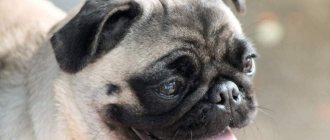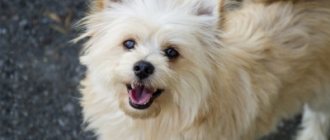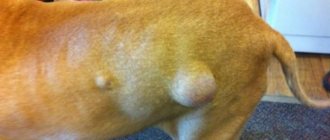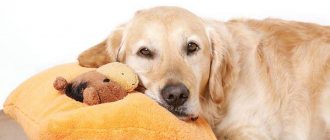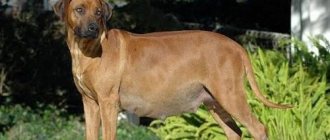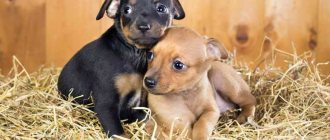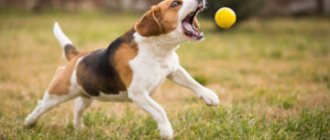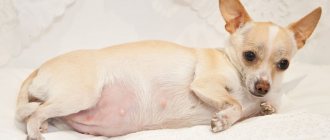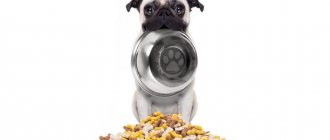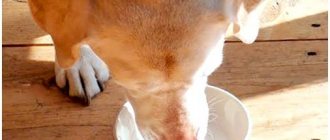The birth of a beloved pet is a very exciting event not only for the dog, but also for its owner. Unfortunately, contrary to popular belief, in most cases pets cannot cope with this process completely on their own. At best, they need our psychological support, at worst, emergency medical care.
Such a complex and dangerous process can easily go wrong as nature originally intended. Human intervention may be needed at any stage, both for the expectant mother and her offspring. Moreover, the problems do not depend on the experience of the woman in labor or her breed; something can easily go wrong due to the physiological characteristics of the body, an uncomfortable position or too high a content of certain substances in the body.
Every owner needs to know the signs of an approaching birth and be able to properly prepare for it.
Causes
Your dog may pant during pregnancy for several reasons. These include :
- excessive heat,
- excitement or anxiety
- pain,
- eclampsia (low calcium levels in the blood),
- other underlying medical conditions such as heart or lung disease.
This may indicate the onset of labor or problems with the pregnancy. Therefore, if the panting is excessive, unwarranted or prolonged, or your dog appears distressed at all, contact your veterinarian immediately.
© shutterstock
What needs to be prepared?
Active preparation begins already in the last month of pregnancy, 7-10 days before the expected date. At this time, a maternity nest and a pen for the expectant mother and her offspring are being prepared. The bitch is gradually accustomed to this place, allowed to get used to it, and made it cozy for her.
Required preparation:
- Place . This is usually a box with tight walls, easy access for humans and the ability for the mother to easily leave the area. For representatives of small breeds (such as Yorkies, Chihuahuas), a medium-sized cardboard or plastic box is suitable. For medium-sized breeds, such as pugs, you need something larger. But for large dogs (German shepherds, huskies, St. Bernards) it is best to arrange such a rookery right in their booths in the enclosure, or build a special large box with strong walls. The dog should fit freely in its nest, but be able to rest against the walls with its paws and back; it will need this during childbirth.
- Equip a pen or playpen in which the puppies will move in the first weeks. The walls should be high enough, but not prevent the woman in labor from leaving it.
- Provide thermal and light conditions in the selected room. Any draft, overheating or hypothermia can be fatal for small dogs, so it is recommended to maintain the room temperature at 28 degrees, gradually reducing it to 20 degrees over the course of a month. It is also worth considering that bright light is painful for animals starting to open their eyes, so thick curtains on the windows and soft artificial light will be a good solution in the first weeks.
- Remove all valuable coverings . Childbirth is messy, so you'll need a supply of spare diapers and towels, and clothes that you won't mind throwing away if something happens. It is better to remove carpets from the room.
- Just before leaving the burden, the bitch, due to nerves and pain, begins to gnaw on everything that comes to hand, so remove everything valuable from its reach.
- Cleanliness is the key to the health of the mother and future offspring , so it is necessary to regularly not only wash and vacuum all rooms, but also disinfect them. Do not approach the mother or babies in street clothes, shoes or with unwashed hands.
Why does a pregnant dog pant but not give birth?
If your pregnant dog is panting but not giving birth, it may or may not be a serious problem. It may be that she is a little warm or worried about something, or it could mean that she has a fever, pain, eclampsia (low blood calcium levels) or other underlying conditions such as heart or lung disease. This may indicate the onset of labor or problems with the pregnancy. Therefore, if she seems at all upset or not quite herself, you should call the vet immediately.
© shutterstock
Caring for dogs and puppies after birth
Childbirth is a process that takes a lot of energy from a dog. Therefore, upon completion of the process, the dog needs peace and rest.
You should not show puppies - the bitch may get scared, because... she worries about them. Indeed, in case of danger (if it seems to her), she may try to hide the puppies by causing them some kind of injury.
If your pet begins to give birth, the main thing is not to create panic . The rate of successful births in dogs is close to 100%. But you should know the stages of this process and, if necessary, ask for help from a veterinarian.
Stages of labor
First, the uterus begins to contract and the cervix dilates, preparing the bitch and puppies for birth. Milk is usually released at this point, but not always vulvar discharge. This time can vary from 0 to 36 hours, but is usually between 6 and 12 hours.
Secondly, the contractions intensify, become more noticeable, and the puppies are born. Typically this time ranges from 30 to 60 minutes (and up to two hours), but if your dog actively strains for 30 minutes without the puppy, contact your veterinarian immediately. If two hours have passed since your last puppy, even if there was no tension, you should also contact your veterinarian immediately. Keep a close eye on your dog during this time, as although the amnion (sac) over the puppy should burst, sometimes it doesn't, and unless the bitch breaks it when she licks, you'll need to break it as quickly as possible. If you see that your puppy has a rupture (it is receding and only the tail is visible), contact your veterinarian as soon as possible. If your bitch has been pushing for 30 minutes and has not given birth to a puppy, call your veterinarian.
Thirdly, the expulsion of the placenta. The second and third stages in dogs tend to alternate: puppy then placenta, puppy then placenta, etc. Sometimes there may be two or three puppies and then their placentas.
Stages of pregnancy
The gestation period in dogs lasts from 52 to 72 days from the moment the egg is fertilized. Physiologically, the countdown begins with the last ovulation, whelping occurs after 62-64 days. Depending on the behavior of the bitch and the development of the puppies, the following stages are distinguished:
- 1-20 days. The dog's behavior remains virtually unchanged. In rare cases, the animal becomes more lethargic, drowsy, and its appetite decreases. Possible toxicosis - vomiting, nausea after eating or at night.
- 20-45 day. This is a time of active growth and development of hearths. The bitch's belly is rounded. At 21 weeks, pregnancy can be confirmed using an ultrasound. From day 25, the concentration of the hormone relaxin in the blood increases. By day 40, the nipples enlarge and milk begins to be released.
- 46-62 days. The dog becomes less active and the size of the belly increases. When touched, you can feel the puppies pushing. During this time, it is not recommended to overload your pet with physical activity or long walks.
Signs of early pregnancy in representatives of small breeds appear on the 50th day, and in large breeds - on the 60th. At this stage, it is advisable to consult a veterinarian and undergo a control ultrasound. Problem breeds: toy terrier, chihuahua, Yorkshire terrier.
Photo: flickr.com
Lack of appetite and trembling in a Pekingese
Good afternoon. Help me please. We have a Pekingese, he is 2 years old. Everyone was vaccinated at 2-3 months of age. Three days ago in the evening I bathed him, he felt fine. The next morning I was hot and shaking, in the evening everything seemed fine again, I ate, played, went outside. But today everything is very bad: he’s shaking, he’s not eating anything, he’s not drinking water. We went to the clinic, took the temperature - normal, stool normal. The doctor gave us two injections - one anti-inflammatory, the other an anesthetic, and prescribed us Phosphalugel and kefir. I came home from the clinic and gave him kefir to drink, and after half an hour the dog vomited, the kefir was yellow. What should I do, help? The doctor said it was a cold or kidney disease.
Answer 3
Puppies, old dogs, and small dogs with reduced immunity suffer from similar diseases. Indicates a cold, lethargy, lack of appetite. The condition sometimes passes unnoticed, without consequences. Weakened immunity allows the disease to take a severe form.
Diet is important. Lack of essential minerals, vitamins and other essential substances weakens the body. Resistance to bacteria decreases. Germs win.
A cold is a consequence of hypothermia. For example, Pekingese dogs should not be taken for a walk after bathing. Other dogs too. Pekingese have a higher body temperature and are therefore susceptible to hypothermia. Drafts have a negative impact. Pets need to be hardened starting from childhood. After washing, you need to dry the dog in a warm, dry room, without drafts.
Representatives of popular breeds are owners of poor health. Breeders sin by lack of attention to the quality of health of their offspring. Puppies are born weak and susceptible to disease. The problem is relevant and widespread.
Older dogs are susceptible to germs and viruses. Immunity is weakened. General physical condition is not good. It's hard to fight. Requires care, care, attention.
Some individuals are guilty of laziness. Inactivity ruins your health. Requires active rest, physical exercise, long walks. Your strength will increase and your health will improve.
Affects the state of the place of sleep. You cannot place a bed in a cold, damp room. It should be dry and warm. Ventilated place, drafts are prohibited. It should not be placed near a radiator. Neutral temperatures are required.
Sick dogs can infect your pet. Street contact is dangerous. The transfer of infection, bacteria, fleas and parasites is possible during play. An organism with a weak immune system is not a fighter.
Cold symptoms
A hot, dry nose is alarming. This is a symptom of the disease. Medical examination required. Additionally, the dog experiences chills and weakness. The absence of other symptoms indicates fatigue.
There are many dog breeds, showing different weights, heights, and body characteristics. It is necessary to know the normal body temperature. Elevated temperature is an alarming signal.
The presence of the disease is accompanied by strange behavior. Lethargy, laziness, and apathy appear. The four-legged friend refuses to eat or play. The dog whines and growls.
Symptoms include discharge from the eyes and nose. The dog has snot, tears, and drooling. The presence of purulent and bloody impurities is dangerous. Urgent medical assistance is required. The presence of the virus is accompanied by colorless discharge. The dog sneezes, coughs, spewing out clear liquid.
An animal that has caught a cold is shivering and feverish. The acute phase is passing. Self-medication is ineffective. You will need to seek medical help. A symptom of a cold is dull fur. Sluggish, rumpled appearance.
First aid
A sick animal needs water and a balanced diet. Those who refuse to eat are given meat broth. The liquid is heated to body temperature. Pour in carefully from the side of the mouth.
The bed is moved to a warm, dry room. Drafts are eliminated. The bed is a heat-preserving material. Warmers and heated packaged salt are placed on the shuddering animal.
Your pet's body will respond positively to the massage. It should be accompanied by drinking water. Massage movements circulate blood and lymph, have a tonic effect, and relax. Nasal and eye secretions are wiped with clean tissues. Moisturizing drops help.
The animal should be taken to the doctor wrapped in a blanket. Along the way, the patient is stroked and reassured. Acute symptoms require urgent intervention. The doctor will examine you and prescribe treatment.
Consequences, prevention
Untreated ailments develop into serious illnesses. A cold turns into kidney disease, pneumonia and others. Regular colds reduce immunity. The body is weakened.
Regular walks and physical activity improve your health. Fresh air strengthens your four-legged friend. A balanced diet is part of health prevention. Living conditions ensure the absence of illness.
Excessive care makes a dog sissy. Excessive wrapping in clothes, short walks, and overfeeding have a negative impact. Thermoregulation is disrupted. Such an individual is susceptible to infections, viruses, and temperature influences.
Puppies are gradually hardened. Each walk increases the time spent outside. Additional clothing is a last resort, except for owners of decorative dogs. Nutrition includes the necessary micro and macroelements. Water must be freely available. Plus, regular visits to the veterinarian are necessary.
Dry and warm nose
A dry and warm nose is normal for dogs expecting offspring. During pregnancy, the endocrine system malfunctions. Therefore, the moist tissues of the sinuses become dry. The following reasons are identified that cause temperature changes in the mucous membrane:
- Thermal difference in the room.
- Working air conditioner. If dry skin is observed among family members, this indicates that the air is dry.
- A stressful situation that makes the expectant mother nervous. Begins to worry, instinctively feeling the changes occurring in the body.
The dog breathes rapidly, sticks out its tongue and trembles
Owners of small dogs, such as the Yorkshire Terrier, often experience rapid breathing. Most often, such dogs are kept as a home pillow or toy.
The dog breathes frequently with its tongue hanging out and trembles:
- Therefore, they receive very little attention. The main task of the owners in this case is to feed and groom the dog. However, it is worth remembering that this dog also needs frequent walks and muscle training.
- Therefore, it is necessary to walk them as often as large breeds of dogs. That is three times a day. It is advisable to do this not for 10 minutes, but much longer, so that the dog can run properly and tense his muscles.
- It is precisely because many owners keep such dogs in greenhouse conditions that they often go to the toilet in the diaper, and not outside, the dogs become overgrown with fat and become obese. Problems with the cardiovascular system appear. This is why rapid breathing may occur.
Almost all dogs in the summer, due to the presence of a thick fur coat, can breathe very quickly, sticking out their tongue. This is not a pathology, try to save your pet from the heat.
Vomiting, reluctance to eat
Toxicosis is a painful condition characteristic not only of humans, but also of animals. It appears at the beginning of pregnancy and before the birth of puppies. It is caused by such symptoms as daily nausea, the urge to vomit, and lack of appetite. Indifference to food is fraught with negative consequences: blood glucose levels decrease, fruits may die.
Toxicosis is a significant problem for the owner and his pet. It is necessary to provide all possible assistance to a dog in this condition.
Shaking and signs of a cold in a dog
Hello, the dog is shaking all over, can barely walk, his eyes are red, his nose is stuffy, he eats and drinks little. In a dream, it constantly twitches, shocks are heard in the cranial region, the jaw constantly trembles, and sneezes. What to do?
Answer 4
The kidneys are an organ that maintains the water-salt balance of the body. They remove harmful substances, toxins and other substances. Organ functions are impaired. Diseases develop. The tissues that form the organ die, which causes autointoxication. The water-salt balance is shaken. Dogs of different breeds, ages, and weight categories are at risk. The disease manifests itself at a late stage.
The disease manifests itself in various ways: acute, chronic forms. The acute form occurs suddenly. Eliminated by treatment. Symptoms are characteristic of the early stages. Contribute to the development of infection, parasites, poisoning, dehydration. Problems with urination make the situation worse.
The chronic form is typical for old dogs. Causes lifelong impairment of organ functions. The kidneys are failing. This is a typical ailment of older animals. It is provoked by the lack of treatment of acute forms of diseases and pathologies.
Symptoms
The acute form of the malaise affects appetite and thirst. Accompanied by frequent urination. The pet experiences weakness, lethargy, and does not respond. The dog refuses to get up and constantly lies down.
The body gradually swells. The body temperature rises. The mucous membrane turns pale and acquires a bluish tint. The oral cavity becomes covered with ulcers.
Chronic malaise is accompanied by thirst and rare trips to relieve oneself. Body temperature decreases. The mucous membranes are dry, the nose is hot. There is a pungent odor coming from the mouth.
The body is exhausted. Weakness is accompanied by vomiting and diarrhea. The animal refuses to eat. Reacts poorly to irritability. The body is chilling.
Help
Providing assistance requires an accurate diagnosis. The animal needs to be examined by a doctor. A number of studies are being carried out. Tests are being taken.
Internal solutions are used to relieve intoxication. Bacteria are destroyed by taking antibiotics. Cleanses the blood. The body undergoes thorough cleaning.
Treatment is accompanied by taking heart medications. Probiotics are prescribed to normalize the functioning of the digestive system. It is recommended to take vitamins. A balanced diet is maintained.
Food containing phosphorus compounds is prohibited: buckwheat porridge, fermented milk products. Reduce the percentage of fish, meat, chicken in the diet. The normal functioning of the affected organs is supported by the consumption of vegetables and foods containing vegetable fats.
Meals are repeated four or five times a day. Small portions are provided. Products are thermally processed. Shredded food is digested faster.
It is prohibited to give bones to your pet. Also prohibited are sausages, cheeses, smoked foods, and sweets. Broths, porridges, boiled minced meat, and cooked vegetables are considered healthy dishes. Food is flavored with oil. The pet store market offers ready-made food for dogs with kidney failure. Veterinarian consultation required.
Red eyes
Sleepy animals have reddened eyes. Other situations signal illness. Tears accompanied by discharge of blood and pus indicate the presence of a brain or eye injury. Accompanied by dilation of the pupils and the appearance of blood vessels.
The eyeballs could be affected by a foreign body or chemicals. Evidence of swelling in the area, paws reaching towards the eyes, blinking, tears. The dog will whine and scratch its face. It is necessary to isolate the affected area.
Allergies cause coughing and sneezing. Eyes turn red. Tears and snot flow. It is difficult for the patient to breathe - the mucous membrane swells. This is how the body reacts to chemicals and irritants.
The body reacts to the virus with reddened organs of vision. The cornea becomes cloudy. Tear production increases. The eye area swells. The dog blinks frequently.
High blood pressure causes you to vomit blood. Vision decreases. The patient breathes quickly. Fainting is possible.
Anemia is a lack of iron-containing substances. In addition to redness, breathing problems arise. The mucous membranes turn pale. The desire to eat disappears, lethargy is present.
Tearing
Normal discharge from the eyes is of a natural nature if it is clear in color and without impurities. They moisturize the cornea and help remove small foreign bodies. Excessive amounts of natural discharge from the eyes are caused by small particles of dust and debris. If your dog feels discomfort: blinks frequently, rubs the eye area with its paws, you should consult a doctor. The presence of whitish, yellow, greenish mucus should be a cause for concern. Such discharge is a sign of a developing infection.
